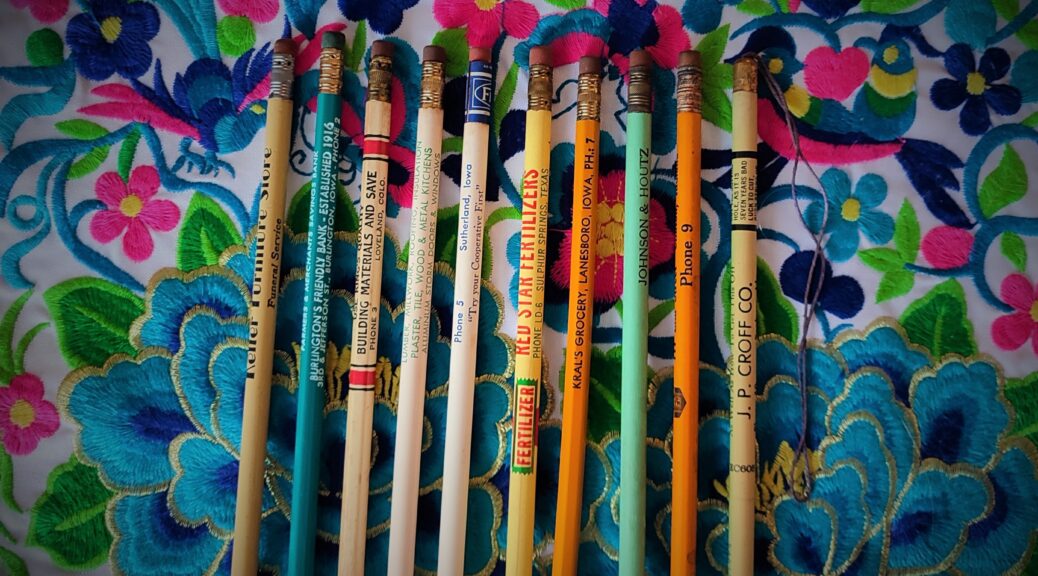
Point to Paper – The business that had phone number 1, who did they call?
Imagine that once upon a time there was a company you could call by just dialing one digit. I wonder what made them invest in the new phone technology. Not to mention the company with phone number 1. Who were they to call? What motivated them to get a phone? Believe it or not, I actually know the name of one such company.
You might be wondering how I know this. It has to do with pencils. I also think it is a bit strange that the company with telephone number 1 had promotional pencils with their number on it. It probably looked cool and modern, but which customers did they think needed the number? The eight or nine others in town, who at that time also had single-digit telephone numbers, certainly had no trouble remembering who had which number.
Regardless of the original motives, the advertising idea had a nice side effect. I don’t think it was part of the plan, but thanks to these pencils I can write about the company in 2023. Both Anders, who writes most of the posts on this blog, and I, have worked a lot on finding out about old companies. Most closed down businesses have one thing in common; their history is quickly forgotten. There are often surprisingly few traces left behind. Some of the promotional pencils I write about may be the only surviving trace that shows the company ever existed.
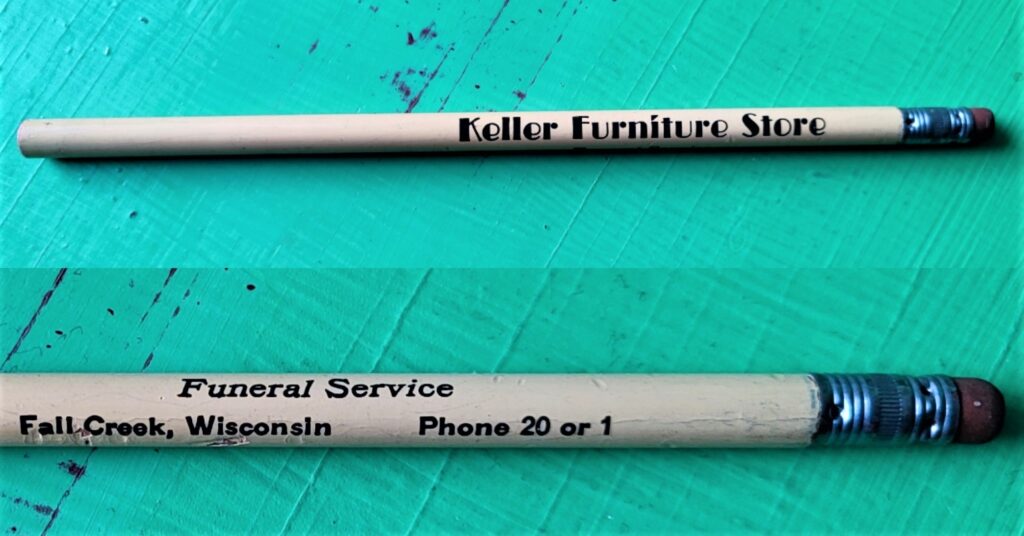
The first pencil I’m going to present is a weird one. In Wisconsin in the US, there was a funeral home that had the telephone number 1. The company was strange in several ways. It was a combined furniture store and funeral parlor. The pencil read: Keller Furniture Store – Funeral Service – Fall Creek, Wisconsin – Phone 20 or 1. Based on what is written on the pencil, it almost seems that the business was primarily a furniture store that also offered funeral services. In this store it seemed to be possible to buy a coffin for a relative who had recently passed away, get the person dressed for the funeral and at the same time buy a couple of extra chairs for the memorial service. That both feels both odd and strangely practical. Today there is a library in the building where this company was located. The library is called Fall Creek Public Library . They bought the property from the original company.
The post this time, as you may have already understood, is about promotional pencils. They are not just any promotional pencils. It’s about some really rare pencils. The pencils I am writing about share one common feature. All the companies had either one-digit or two-digit telephone numbers. All the companies were American. I will present a business for each of the telephone numbers with the digits from 1 to 9, as well as the digits 10 and 20. The business you just read about had both the telephone numbers 1 and 20.
This little bundle of pencils is the strangest collection I own. I will do my best to educate you about their strangeness. To get to know the pencils, the companies and some of the history of short telephone numbers, I will take the readers on short trips to a number of places around the world. We will visit Vieng Xai and Vientiane in Laos. In Norway, we will visit Ålesund, Førde in Sveio, Karasjok, Drammen, Kristiania, Bergen, Espeland, Ådnamarka and Indre Arna. In the US, we will visit all the small and large towns where these pencils come from. We will visit Fall Creek, Loveland, Burlington, Lincoln, Sutherland, Sulphur Springs, Lanesboro, Quincy, Clinton and Rexburg. In Rexburg you will also get some old news about local pike fishing. There will even be some magic. In between, of course, there will be mental detours. As usual, there will be a number of more or less relevant digressions. All the detours will be phone or phone number related.
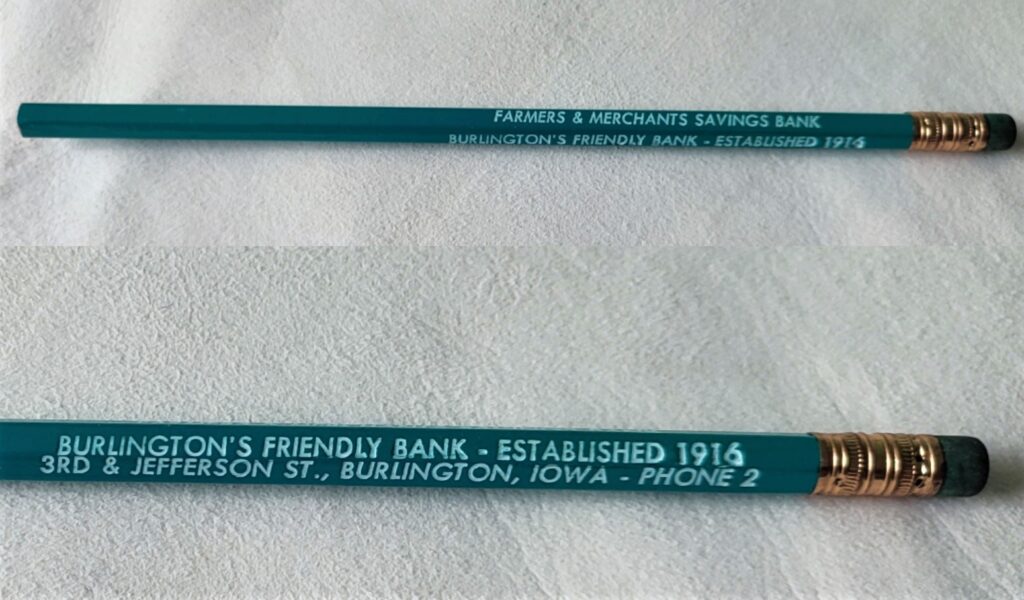
The pencil with telephone number 2 belonged to a bank. In Iowa, you could save your money at Burligton’s friendly Farmers & Merchants Savings Bank . It was established on the 1st of March 1916. The bank still exists. They are still on the same street in Burlington. The bank is today called F&M Bank & Trust. I am not sure when this pencil was made, but the long brass ferrule, the part that holds the eraser in place, suggests that this may be a pencil that was made before 1930. I have contacted the marketing department of the bank and asked when they had phone number 2. I am still waiting for further information.
While we wait, I suggest a quick trip to Laos. Although this post is neither about the Democratic People’s Republic of Laos, nor the books written by Colin Cotterill, there is a series of books where all the action takes place in Laos. The series is written by Cotterill. One of the books in the series was the source of inspiration for today’s topic. If you lack reading material this autumn, and you like Laotian crime fiction, or you just became curious about Laotian crime fiction, whether it’s because you don’t know where Laos is, or because you had no idea that there existed crime fiction from this country, I can warmly recommend the books written by Colin Cotterill. Bryan Thao Worra writes :
“Colin takes some liberties, but remains faithful to Lao culture as a whole,” says Lao-American poet Bryan Thao Worra, who edits Bakka Magazine, a Lao literary journal. Native readers who have read the English editions, he adds, love the books, which “can [also] be a very interesting way for foreign readers to become acquainted with Laos.”
Should your curiosity for the beautiful country of Laos be further awakened by the strange stories of Dr. Siri and his interesting helpers, and you want to broaden your horizons with an alternative perspective, then I can further recommend to you Jane Hamilton-Merritt’s deeply moving documentary “Tragic Mountains”. The book is about the Hmong people’s struggle for freedom in Laos. It takes you into a world you probably didn’t know existed. After reading the book, you may realize that it describes something you should have known. The Hmong people’s story has been forgotten and kept hidden for far too long.
I is difficult to compare the books of Cotterill and Hamilton-Merrit. They have very different perspectives. Nevertheless, they both contribute with a multitude of small glimpses into a country I knew nothing about until I had read their books. Unfortunately, all this probably also reveals my ignorance about Laos. I have to admit that there are many countries in the world that I know next to nothing about. I, like everyone else, had to start somewhere. This happened to be my starting point.
On to the point relevant for this post. I am thinking about the point that shows the source of inspiration for me becoming interested in short telephone numbers. According to the fictional pathologist detective Dr. Siri Paiboun, who is the main character in Colin Cotterill’s books, Laos had less than 900 telephones in 1976. In one of the books, Disco for the Departed , set in 1977, nurse Dtui calls from the village Vieng Xai. The village is located in the north of the country. She calls the capital Vientiane in the south. It is pointed out in the book that she dials a four-digit number. The capital of Laos therefore used four-digit telephone numbers as late as 1977. Four digits? Of course I became curious.
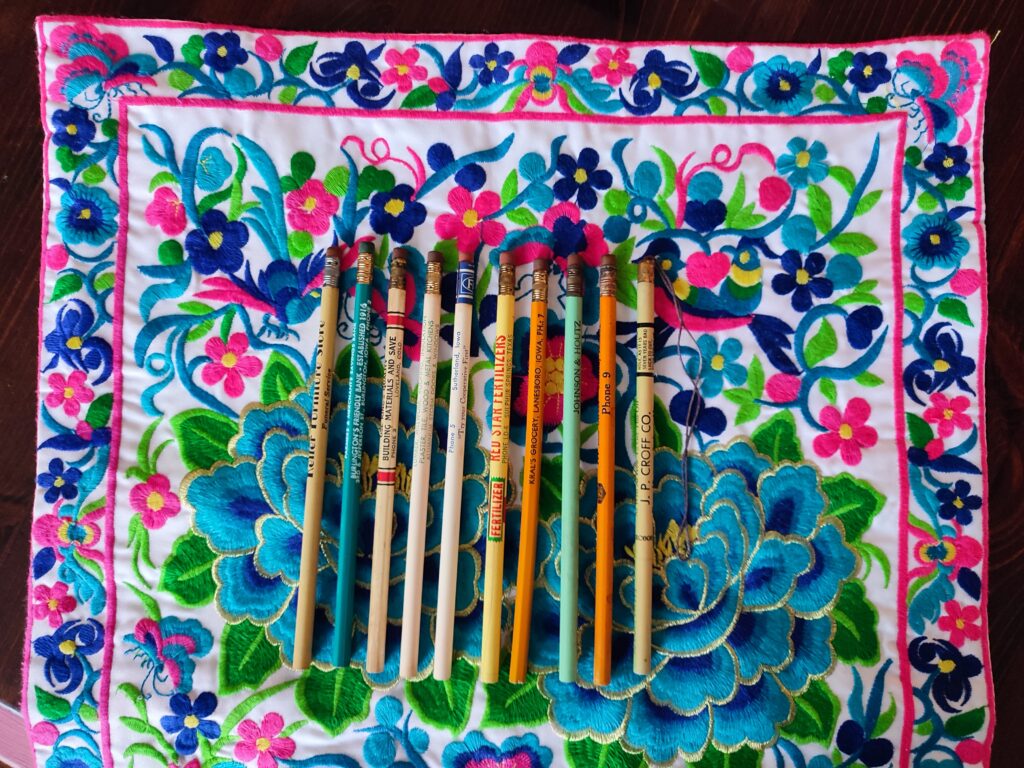
A couple of years later, specifically in the fall of 2022, I happened to come across a large collection of pencils that was up for sale. Most of it had already been bought by other keen collectors, but a small series of pencils was still not sold. I wrote to the seller and he could tell me that he had collected pencils all his life. He had now arrived at an age when he thought it was time to let others enjoy the collection. He was very fond of the strange advertising pencils. He had spent many years creating the collection of advertising pencils with the telephone numbers 1-10. He doubted that anyone else could do the same today. Who could resist such a temptation? At least not me. The new owner became me. Maybe I now own the rarest and strangest pencil collection in the world. How cool is that? As usual, part of the fun with everyday items like this is the moderate price. I therefore took over an extremely rare collection for a very reasonable sum of money. The most important thing for the seller was that the pencils would get a good home. That promise was easy to make. The collection is so unique that I thought it also deserved to be shared with the blog’s readers.
At one time or another, telephone subscribers in most places in the world had four or fewer digits in their telephone number. According to the Springfield-Greene Library District in Missouri, the telephone book that listed all the telephone subscribers in Springfield, had one- to three-digit telephone numbers as early as 1892. The city’s subscribers had four-digit telephone numbers in the 1905 telephone book and five digits in the 1917 edition. Another example is an advertisement in The New York Times from 1882. That year, one of the city’s undertakers, in what was already a large and modern city, had the telephone number “Spring 255”.
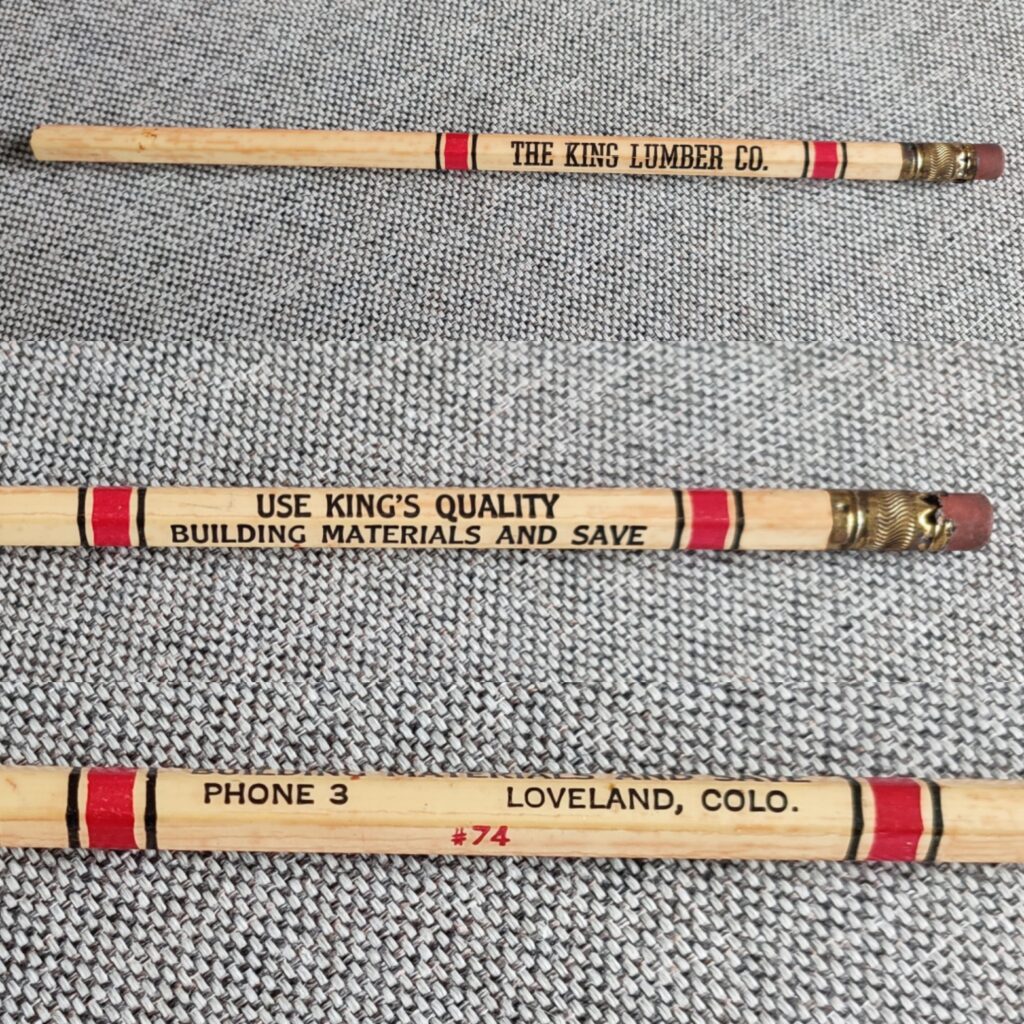
Telephone number 3 belonged to The King Lumber Co. The company was located in the city of Loveland in Colorado. The town was founded in 1878. There had recently been build a new railway line in the area and the settlement had been moved closer to this. In 1882 the town had 250 inhabitants and in 1885 the town passed 900. Today, it is a central city to the rapidly growing region of NoCo (Northern Colorado). Should you have a special interest in Colorado and the city of Loveland, I can recommend a book written by Jeff and Cindy Feneis: “Exploring Loveland’s Hidden Past, the People and Places of Early Loveland, Colorado”. I’ve talked to Jeff about the pencil. He thanked me for sharing new and unknown history about the city he has written so much about. He has shared the information with his historically interested friends in Loveland. I was promised a response.
Within a few months, I received replies from both Bill and Ashley. Jeff Feneis’ friend Bill Meirath, who is a member of the Loveland Historical Society, was able to tell me that single-digit telephone numbers were used in Loveland from the 1890s. The King Lumber Company, according to an advertisement Bill had found, could actually be reached with a singel digit telephone number at least until 1954. During the 1950s, Loveland received five-digit telephone numbers and during the 1960s they increased to seven digits.
Another friend of Jeff’s, Ashley Yager, who is the Collections Manager at the Loveland Museum, could tell me that The King Lumber Company was started in 1909 as Loveland Lumber. She believes the company changed its name sometime between 1935 and 1947. The reason is that The King Lumber Company is not mentioned in the 1935 phone book and is only found first the 1947 phone book. She admits that she is missing the phone books between these years. I think that places the changing of the company name before World War II. The reason is the metal ferrule on the pencil. That was not legal during the war and a short time after. All metal was to be used for the war industry. The ferrules that held the erasers in place on the pencil had to be made in other ways. We will return to that. It probably means that The King Lumber Company changed its name from Loveland Lumber between 1935 and 1939. The pencil with telephone number three printed on it feels even more valuable now. It has helped me making three new American friends and has contributed that i have learned a lot about the city of Loveland. It’s really amazing that not more people are collecting pencils.
Did you know that according to the Norwegian version of Wikipedia, Norway’s first telephone call was made as early as 1876. It is quite remarkable considering that Alexander Graham Bell was credited with inventing the world’s first working telephone system in that same year. It is claimed that this happened because the Norwegian Joakim Anderssen sat on the jury for the world exhibition in Philadelphia in 1876. He bought two telephones which he sent home to his son Jens. Norway’s first telephone call was thus made in Ålesund as early as 1876. Dear people of Ålesund, did you know that your city was a pioneer city in the use of telephone technology both in Norway and the rest of the world? The phone call was conducted between father and son Anderssen. It went between his father’s home and his company. The following year, in the summer of 1877, the telephone was demonstrated in Kristiania, Drammen and Bergen. The telephone officially came to Norway in 1880. Per Otto Borgen writes about the the telephone coming to Drammen in the Drammen City Encyclopedia (my translation to english with additional help from Google translate) :
In 1880, the “Internationale Bell Telephone Co.” got permission to install a telephone system for the city of Drammen. The operation of the Drammen telephone system was opened in August with 20 subscribers, after Alexander Graham Bell had personally come to Drammen to demonstrate his invention. After the first telephone call had been made, one of the speakers, Cavalry Master Jacob Borch, is said to have said: “Yes, gentlemen, it is a very amusing toy, but it will never have any practical application!” In 1881, a telephone line was built between Drammen and Mjøndalen, the number of subscribers was then 90. In 1885, the station was moved from Wilsongården to magistrate Gløersen’s farm in Øvre Strandgate. In 1889, Bell’s license was transferred to the newly formed “Drammen Telefonaktieselskab”, the total length of the telephone lines was then 170 km and the number of subscribers 139. The subscription fee was NOK 100 (approximately $10) provided that the subscriber stayed less than 150 m from Bragernes Torv, beyond this limit the telephone company could calculate an additional NOK 10 (approximately $1) per year for every extra 500 metres.
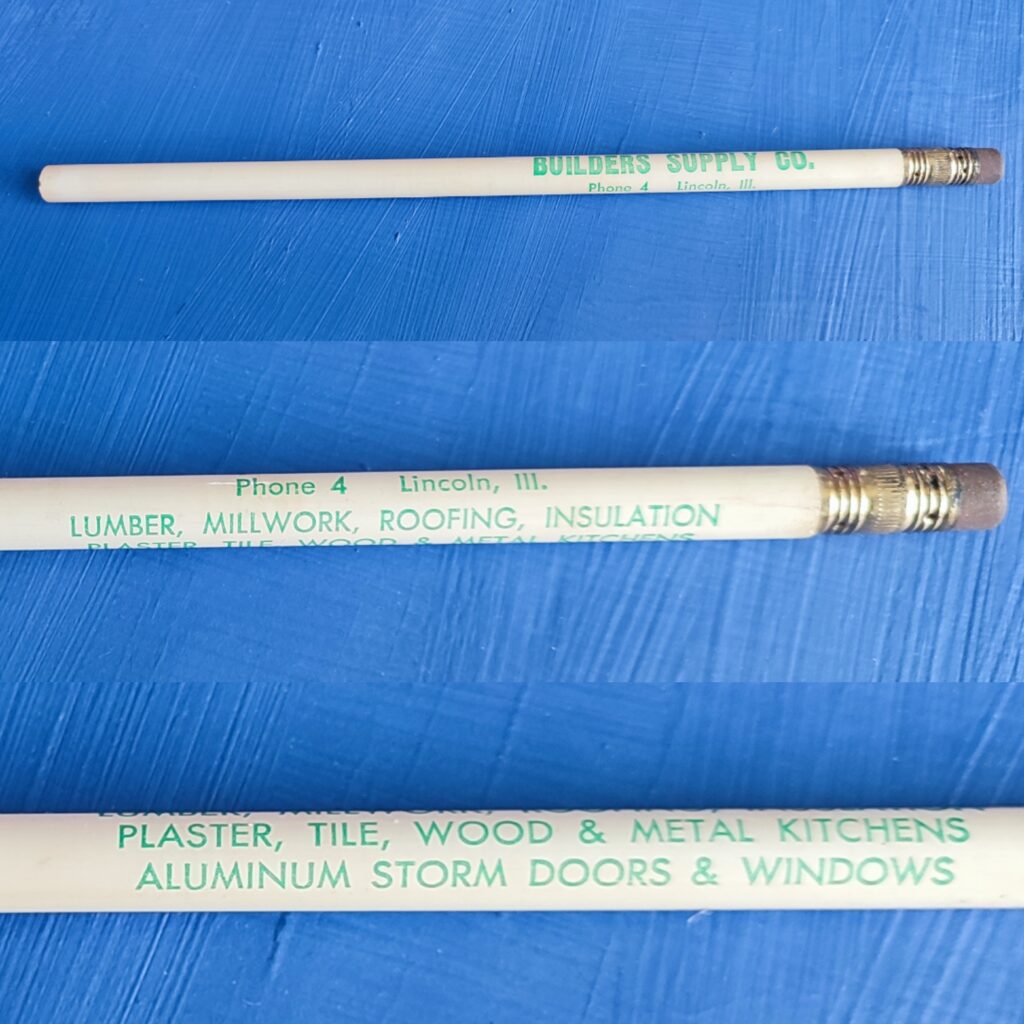
Phone number 4 belongs to Builders Supply Co. The company was located in the city of Lincoln, Illinois. It has been difficult to find out anything more about this company. They made kitchens in metal and windows in aluminium. Aluminium windows are older than you might think. According to this link, about the maintenance of listed windows, the first aluminium windows were made in the USA as early as 1912. I believe that the pencil was made before the Second World War. Both the ferrule and the condition of the eraser point in that direction. We have already talked about the brass ferrule, but sometimes the condition of the eraser can also give an indication of the age of old pencils. Poor storage can produce similar characteristics, so we cannot judge the age from the eraser alone. Consider that this little pencil may be the only remaining memory of the business it was once created to promote.
I have lived through a number of telephone historical events. After all, I am 55 years old, so a lot has happened during the years I have lived. The telephone number to our home in Indre Arna, where I lived for part of my childhood and adolescence, had only six digits in the 1980s. They were easy to remember. If you wanted to call us, all you had to do was dial 24 25 86. On the other end, you would hear someone answer politely: “Kversøy, at your service”. A friend, who grew up in Førde in Sveio in Sunnhordland, was not very impressed that we had a six digit phone number. He told me recently that they still had two-digit phone numbers in the late 1970s. Maybe even in the early 1980s. If you were to call Christoffer Tjelle and his family in the 1970s, all you had to do was dial phone number 80. Christoffer grew up in the apartment building where the local manual telephone exchange was placed. It was located in the apartment of his neighbor. If you were interested in the latest news, the manual telephone exchange was the right place to be. The last manual telephone exchange in Norway was closed in 1993. It was located in the center of the city of Karasjok. The ladies at the telephone exchange both connected conversations and provided interpretations between Sami and Norwegian languages.
We used area codes in Norway until 1993. Before this children and young people in the household were only allowed to use the telephone after 5 p.m. Then the phone was only to be used for short, absolutely necessary calls. After 5 p.m., you only payed for one unit of time regardless of the actual length of the call. We were only allowed to make local calls. Any call outside your area code would cost much more. International calls, like today, had different prices depending on the country in question. Such calls were only for rich people or for very important good news, crisis calls or to inform about death in the near family.
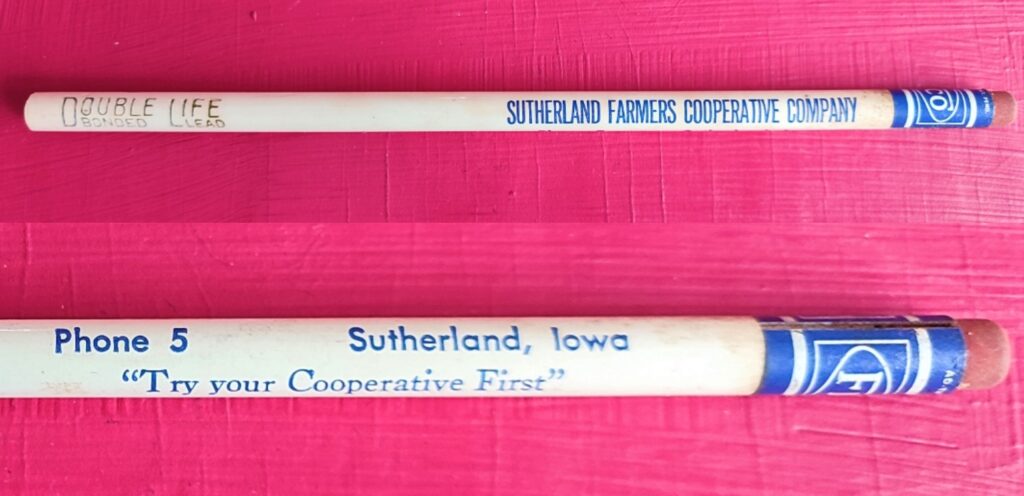
The company that had telephone number 5 was Sutherland Farmers Cooperative Company . I think the pencil in the photo was made during World War II or shortly after. This was a period when there was a shortage of metal. That meant that the ferrule that held the eraser in place often was made of cardboard. Here you can see an example of a wonderful ferrule made in cardboard. The eraser is in surprisingly good condition. The pencil has probably been stored in a dark drawer out of reach of the harmful sun. Rubber and sunlight are not an ideal combination.
The Sutherland Farmers Cooperative Company was located in the town of Sutherland, Iowa. They appealed to local patriotism and encouraged customers to “Try your Cooperative First”. That’s actually all I know about this company. I have not found a single trace of the company ever existing beyond this. Perhaps this pencil is also a last memory of a company that no one seems to remember. There is a last straw of hope that may help to date the pencil itself. I know that several promotional pencils from the same period had the text Double Life Bonded Lead . You can see this text written all the way towards the tip of the pencil. I am grateful for tips from the readers if anyone knows anything about the age of pencils with this printed on them.
When I was growing up, most people remembered the phone numbers of the most important people in their lives. In addition, many had handwritten telephone books with the numbers of relatives, friends, important contacts and business connections. There were also quite a few people who remembered all their important phone numbers by heart. It was claimed that my grandmother Margot Kversøy remembered most telephone numbers in her local area until they started with six digits. Remembering many phone numbers gave status.
I still remember my girlfriend Eva’s number. She lived in Bergen and had the number 96 13 21. Between Indre Arna and Bergen there was only the local rate for calls. Arna was part of Bergen municipality. It was bliss to be able to steal a few minutes on the phone and call my girlfriend. I sometimes got scolded by my mother for occupying the phone for too long, but with the afternoon rate and the possibility for a romantic conversation, it was difficult to limit myself. Texting and emails were still part of an unknown future. I think these phone calls were a good investment. This year, I have been married to my girlfriend for 33 years.
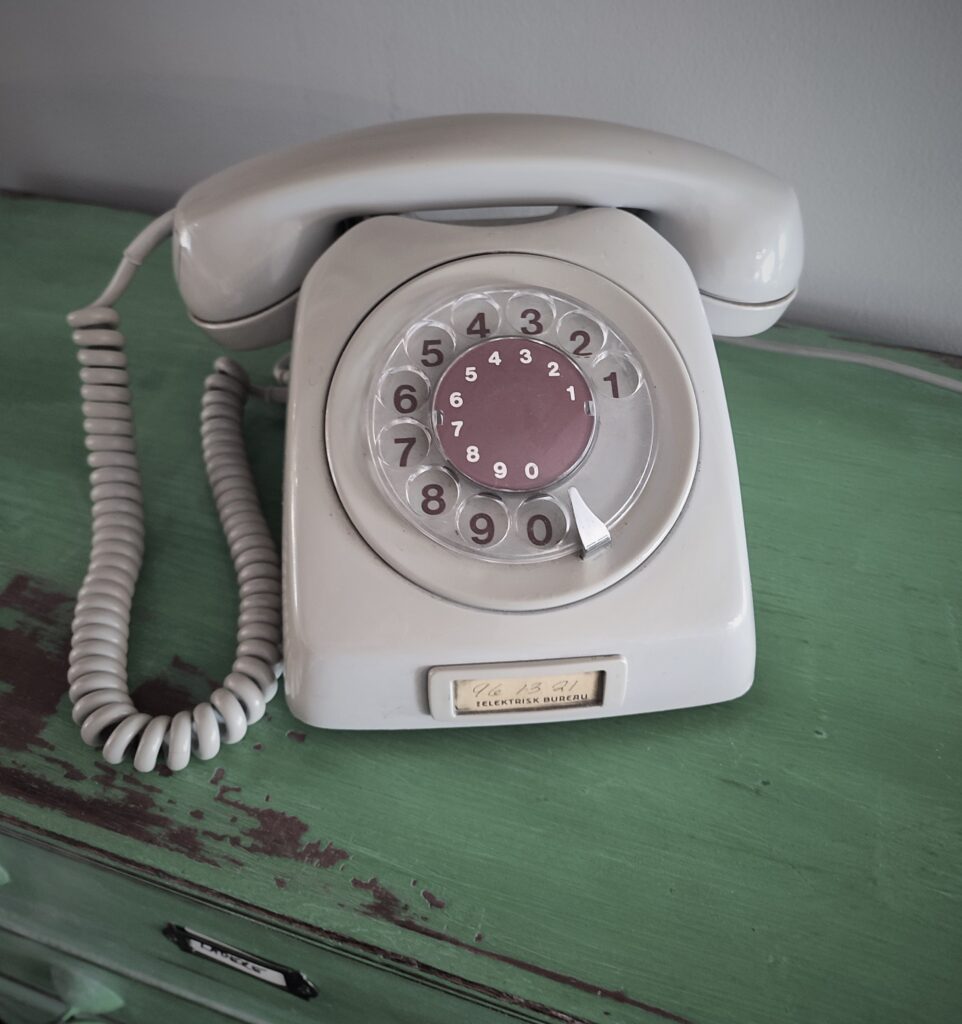
Privacy and telephony were a difficult combination unless you were alone at home. The telephone was usually located in a central location in most houses. It was also preferably a place where everyone could hear what you were talking about. We had the phone in the hallway outside the bathroom. It was really a luxury. The proximity to the bathroom gave some opportunity for privacy. I could take the phone with me as far as the cord would go. It reached just inside the door. I could sit there and chat with the door slightly ajar. With hushed voices we could whisper secrets to each other without anyone else in the house hearing it. I couldn’t close the door completely because then the cord could get pinched. Pinched wires don’t last long. Destroying a phone was an unthinkable crime. The telephone was the lifeblood of most homes and had to be taken very seriously. The telephone set itself was in many periods until the 1970s difficult to get hold. Many telephone sets were used for 20, 30 and even 40 years before being replaced. We were amazed by the liberal use of telephone sets, the variaty og colors and all the talk on the phone when we lived in the US in the mid 1970s. This was an extravagance that was unheard of in Norway at the time. The phones in Norway were black or grey and were used as little as possible.
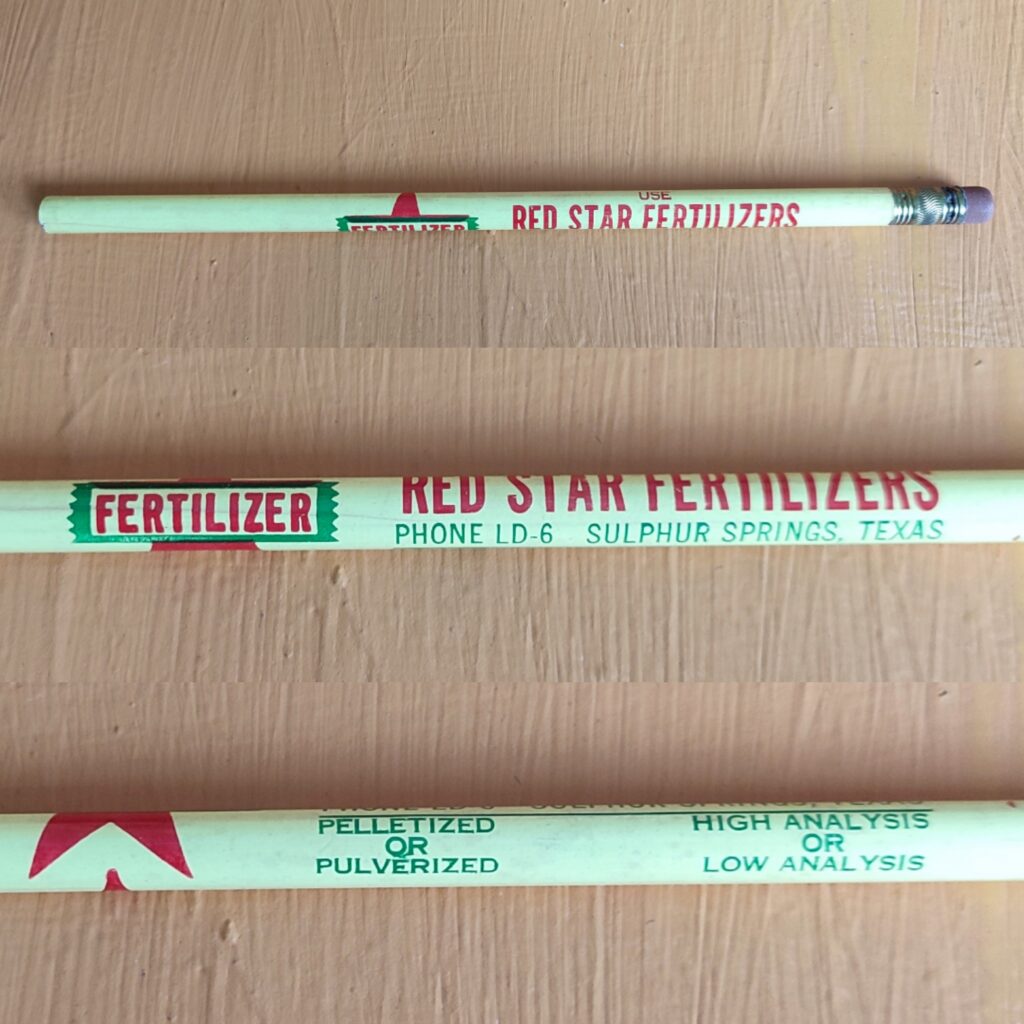
Then we have come to the pencil that marketed the company with phone number 6. Red Star Fertilizers was located in Sulfur Springs, Texas. They offered artificial fertilizers both in the form of pellets and powder. Readers with agricultural expertise may be able to explain the relevance of the caption High analysis or low analysis. Red Star Fertilizers is another company that has been difficult to find out more about. The only thing I’ve been able to dig up is a court document from 1957 about an incident that happened in 1956. This was a case between the Pan American Incurance Company and Clyde Couch . The case was in the Texarkana Court of Civil Appeals. The document concerns an employee who is struggling to get occupational compensation after a fall from a great height. Clyde Couch had climbed a ladder on the factory grounds to inspect a tank containing ammonia. He had probably inhaled too much of the gas with its strong smell and lost his balance from the shock. Anyone who has taken a sniff of a bottle of ammonia knows what I’m talking about. Be very careful if you choose to try the same yourself. I can remember my grandfather having fun tricking us into smelling a bottle of diluted ammonia. He was really the kindest man in every possible way, but right there he showed that he had a mischievous side too. It was an effective learning strategy. We became quick learners. We were not deceived more than once each.
An alternative to the landline at home was to use one of the red public coin-operated phone booths. They were located in central places in every village, town and city in Norway. There was often a queue. Not everyone had a telephone at home. Impatient voices and listeners with interested ears made longer personal conversations difficult. Our most important local phone booth was right next to the hot dog stand in a place called Ådnamarka. It was also right by the Cooperative Supermarket. Private conversations were of course out of the question. If the aim was to spread gossip, then the location was ideal.
I have many fond memories of phone booths and landlines. In retrospect, I see that the lack of access to phones was an underestimated gift. One advantage was that you could always say you could not be reached because you were not going to be near a phone. I often miss that. That excuse was always valid. It was also mostly true. The hunt for a phone could also throw you into unexpected adventures. For example, you could struggle to get hold of a phone when something unexpected happened in an unexpected place. Your cars engine stalling could mean that you had to knock on the door of the nearest house you could find and ask nicely if you could borrow the phone. Most people said yes. Maybe you got both help and a cup of coffee in return. I can’t remember ever being turned down.
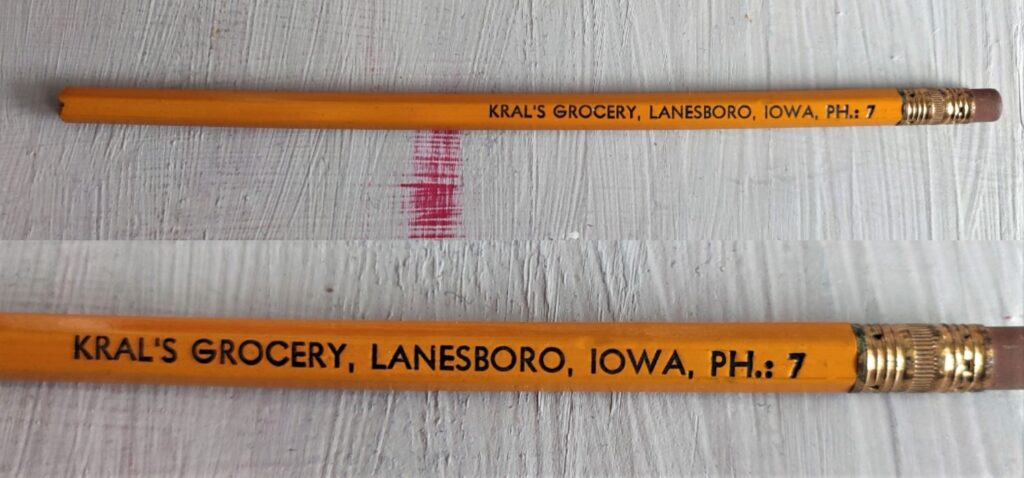
The pencil with phone number 7 marketed a grocery store. Kral’s Grocery was located in Lanesboro, Iowa. Today, this is a small beautiful town. At the 2022 census, there were 118 people living in Lanesboro in 56 households. Lanesboro this year had five businesses. There is no record of what happened to Kral’s grocery, but I know that as late as 1940 there was an empty lot across the street from the store. On this lot, free westerns were shown on Saturday nights. I also know that it was Frank Kral who ran the shop as late as 1943. I have tried to get permission to use a picture from the shop itself. Unfortunately, I have not received a reply from the owner of the picture. The picture in question was taken in 1943. The best I have managed is a link. You can find the picture at this link. Here you can read how Lanesboro markets itself in 2023:
Living in Lanesboro, IA is like living in rural paradise. The town offers a peaceful atmosphere with quaint shops and restaurants as well as a variety of outdoor activities. Residents can enjoy fishing, camping, biking, or simply taking in the beauty of nature along one of the many hiking trails. With its small-town charm, Lanesboro offers a great place to raise children, retire peacefully or even just take a weekend getaway from the hustle and bustle of city life. Community events such as festivals and parades are also popular throughout the year and make for an enjoyable time with friends and family. All in all, Lanesboro is an idyllic spot that any outdoorsy or community-minded individual would love to call home.
If you miss the peace and quiet of paradise, all you have to do is move to Lanesboro. Life then becomes like a continuous wonderful dream consisting of walks in nature, fishing, cute little shops, family life and local festivals. Who could wish for more?
I have seen parts of the telephone directory from the Lanesboro Mutual Telephone Company from 1939. All the subscribers then had two or three digit phone numbers. For example, the Launspach Cafe, which in addition to food also sold cigarettes, beer, ice cream and candy, had phone number 82. A. Dillivan, who managed the local gas station, had the number 39. In the neighboring town of Carroll, which used the same telephone company, the chiropractor F.A. Stamp had the number 850.
The village of Espeland in Norway, where my grandmother Margot lived, is almost like a big city if you compare it to Lanesboro. Espeland was a place outside the city of Bergen full of enterprising and hardworking people. Espeland had, among other things, a cinema, a used car dealeship (my grandfather Konrad’s business), a shoe shop (Flatabø – where I bought my first Nike Air Jordan High in 1985 – presumably worth more now than when I bought them [both the shoes and the shop still exist]), shoe factory (Kippersund), sports shop (Randolfen), cooperative (where my great-grandmother Signe was an early female role model as the Cooperative Supermarket and Dairy manager), butcher, clothing store (sold Atomic Jeans) and the clothing factory (Janus – woolen underwear for winter). In addition, the river was full of trout and salmon. It was also never far to the nearest house of worship.
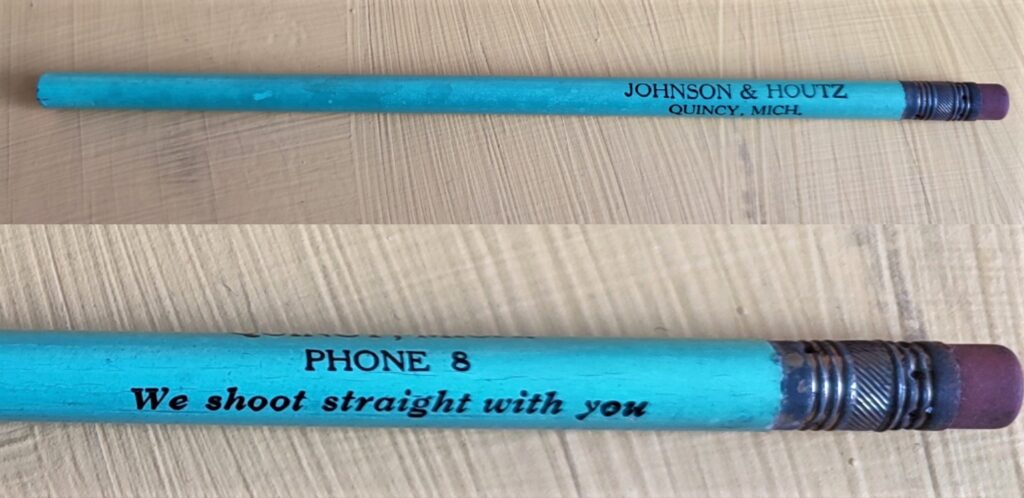
The pencil with phone number 8 was marketed by the company Johnson & Houtz from the city of Quincy, Michigan. They would like you to know that We shoot straight with you . Whether they were trying to tell you that they were sincere lawyers or honest used car dealers, or they simply sold guns, I have no idea. The ferrule on the pencil also this time looks like it is from before 1930. I have tried to find out about this company, but I can’t find the slightest trace. The small town of Quincy got a post office in 1936 and had just over 1,500 inhabitants in 2020. According to Wikipedia, the town is associated with the television journalist Jill Dobson from CBS, the mushroom researcher Bessie B. Kanouse and the senator Samuel Etheridge.
The landline age also had its own peculiar phenomena. Grandma Margot had a black phone made of Bakelite. Bakelite was an early type of plastic. She sometimes used a pencil with an eraser to turn the dial on the phone. The dial had to be turned to the right to dial a number. The sound her phone made was amazing. It was even nicer than the gray phone in the picture above. It was exciting for us kids to see how grandma called someone. We watched with excitement as she efficiently turned the dial for each new digit.
The dialing technique of the individual who was calling was in many cases unique. It was often possible to distinguish between who in the family was using the phone. Some pulled the dial quickly towards the stopper and released it before turning the next digit. Others followed the hole in the disc with their finger both back and forth and were able to force a slightly greater speed between the numbers struck. Some left the phone on the phone table and some held it on their lap. All these elements changed the sound. If you were to make a phone call you dreaded, you might even linger a second or two before releasing the dial after the last digit. The different turning strategies could express everything from efficiency to drama. Many will probably nod in appreciation when I claim that the decline of the telephone already began with the arrival of the first soulless devices with push buttons. Monotonous button pressing on a plastic phone simply cannot be compared to the mechanical symphony of a quality rotary phone made of bakelite and metal.
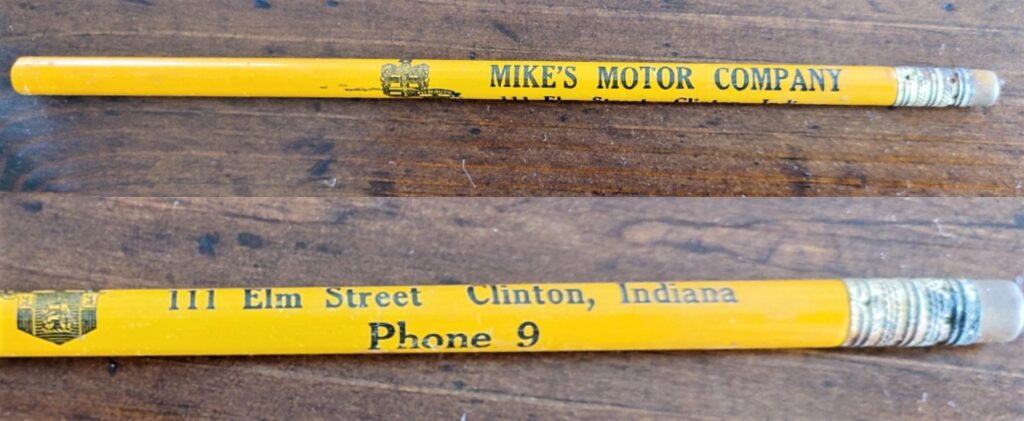
Mike’s Motor Company was located at 111 Elm Street in Clinton, Indiana. The company had phone number 9. Fortunately, not everyone experiences nightmares on Elm Street. Mike’s clearly hasn’t scared away its customers in nearly 100 years. The company was established in 1931 and still operates from the same address. I don’t know when they had phone number 9, but now you can call them with the phone number +1 756 832 5100. I think this may be the first promotional pencil this company made. This makes me think it was made in 1931.
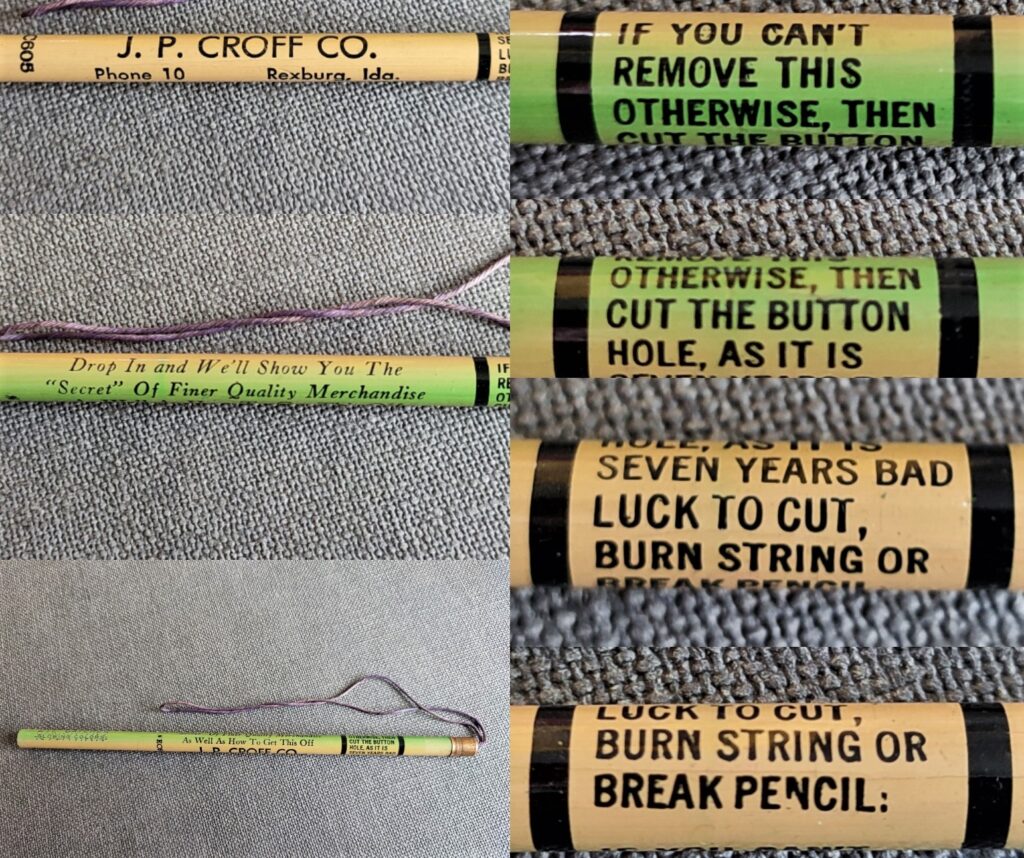
The last pencil in this article has phone number 10 printed on it. It was the number of JP Croff Co. Some of the few things I know about this company are that they were located in Rexburg, Idaho and that they sold hats from the Portis Hat Company. The Portis brand hats were sold all over the United States. On the pencil they wrote that if you pop in, they will show you finer goods. I have seen an old matchbox for the JP Croff company in Wheatland, Wyoming. I therefore assume that JP Croff was a chain of stores. They boldly claim the following in the advertisement on the matchbox:
You’ll look better in a new Portis. Your hat is important. We specialize in hats to fit your face, build and complexion. Our stock of Portis hats is complete. Let us help you choose a style that will complement you.
I want a hat like that. One that suits my face, build and skin tone. One that complements me. I also know what the long message on the pencil is about. It’s a cunning marketing ploy. This is a magic pencil. Let me explain: You might be walking on the street and a person would stop you and ask if you wanted a free promotional pencil. If you answered yes, he would say that you could have it on the condition that he could fasten it to the buttonhole of your shirt. You had to close your eyes while he attached it. The thread is shorter than the pencil, so it is apparently impossible to get it off again. On the pencil it says that cutting the thread or burning it will bring bad luck. If you were superstitious, the only solution was to pop into the nearest JP Croff store. It says on the pencil that they promise to help you and they will show you how to get it off again. I won’t reveal too much about the magic, but you can try this with a regular pencil. You just have to drill a hole at one end and attach a thread that is a little too short. It should then be possible to get the pencil both on and off your shirt without damaging it, opening the thread or destroying the buttonhole. If you struggle with one or more of the steps, and you ask nicely in the comments section, I will reveal the trick.
For those of you who want one last little detour, I can tell you an old news story from Rexburg. David and Kathy Plowman caught a Tiger Muskie that was over a meter in length in Wakeside Lake in the summer of 2015. Are you wondering what a Tiger Muskie is? I know because I just learned it. It is a hybrid between a North American pike and a muskellunge. A muskellunge is also a fish in the pike family. A Tiger Muskie is a non-fertile hybrid. You could read the news in the Idaho State Journal on April 24, 2015.
Also, if anyone of the readers know anything about the companies in this article, I am very happy to get input.
All photos were taken by Kjartan Skogly Kversøy.
Sources:
You can check most of the sources yourself by clicking on the links in the text. The links are marked in blue and are underlined.
2 thoughts on “Point to Paper – The business that had phone number 1, who did they call?”
Thank you for this fascinating account! What a story these humble pencils have to tell.
In both Canada and the U.S. it was once common for the same business to build and sell both furniture and coffins, I suppose because the materials and skills involved were the same for both. In fact, in the area of Canada where I live, there are two long-standing family-owned funeral parlour/ furniture stores dating from 1836 and 1854 (although today the two branches of the business are operated separately, instead of being co-located as they would have been originally). So the story behind your first pencil doesn’t sound all that strange to me.
Would also like to comment on the exquisite piece of embroidery your pencils are resting on. It’s beautiful!
Interesting